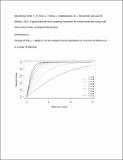Files in this item
A general discrete-time modeling framework for animal movement using multistate random walks
Item metadata
| dc.contributor.author | McClintock, Brett Thomas | |
| dc.contributor.author | King, Ruth | |
| dc.contributor.author | Thomas, Len | |
| dc.contributor.author | Matthiopoulos, Jason | |
| dc.contributor.author | McConnell, Bernie J | |
| dc.contributor.author | Morales, Juan | |
| dc.date.accessioned | 2012-05-18T00:05:44Z | |
| dc.date.available | 2012-05-18T00:05:44Z | |
| dc.date.issued | 2012-08 | |
| dc.identifier | 5051569 | |
| dc.identifier | 5fc1e8aa-1a9d-4f14-a341-e8457c2cc217 | |
| dc.identifier | 84865794640 | |
| dc.identifier.citation | McClintock , B T , King , R , Thomas , L , Matthiopoulos , J , McConnell , B J & Morales , J 2012 , ' A general discrete-time modeling framework for animal movement using multistate random walks ' , Ecological Monographs , vol. 82 , no. 3 , pp. 335-349 . https://doi.org/10.1890/11-0326.1 | en |
| dc.identifier.issn | 0012-9615 | |
| dc.identifier.other | ORCID: /0000-0002-7436-067X/work/29591698 | |
| dc.identifier.other | ORCID: /0000-0001-7575-5270/work/56052208 | |
| dc.identifier.uri | https://hdl.handle.net/10023/2605 | |
| dc.description.abstract | Recent developments in animal tracking technology have permitted the collection of detailed data on the movement paths of individuals from many species. However, analysis methods for these data have not developed at a similar pace, largely due to a lack of suitable candidate models, coupled with the technical difficulties of fitting such models to data. To facilitate a general modeling framework, we propose that complex movement paths can be conceived as a series of movement strategies among which animals transition as they are affected by changes in their internal and external environment. We synthesize previously existing and novel methodologies to develop a general suite of mechanistic models based on biased and correlated random walks that allow different behavioral states for directed (e.g., migration), exploratory (e.g., dispersal), area-restricted (e.g., foraging), and other types of movement. Using this “tool-box” of nested model components, multi-state movement models may be custom-built for a wide variety of species and applications. As a unified state-space modeling framework, it allows the simultaneous investigation of numerous hypotheses about animal movement from imperfectly observed data, including time allocations to different movement behavior states, transitions between states, the use of memory or navigation, and strengths of attraction (or repulsion) to specific locations. The inclusion of covariate information permits further investigation of specific hypotheses related to factors driving different types of movement behavior. Using reversible jump Markov chain Monte Carlo methods to facilitate Bayesian model selection and multi-model inference, we apply the proposed methodology to real data by adapting it to the natural history of the grey seal (Halichoerus grypus) in the North Sea. Although previous grey seal studies tended to focus on correlated movements, we found overwhelming evidence that bias towards haul-out or foraging locations better explained seal movement than simple or correlated random walks. Posterior model probabilities also provided evidence that seals transition among directed, area-restricted, and exploratory movements associated with haul-out, foraging, and other behaviors. With this intuitive framework for modeling and interpreting animal movement, we believe the development and application of bespoke movement models will become more accessible to ecologists and non-statisticians. | |
| dc.format.extent | 15 | |
| dc.format.extent | 888600 | |
| dc.format.extent | 111424 | |
| dc.format.extent | 186272 | |
| dc.format.extent | 4942 | |
| dc.format.extent | 57279 | |
| dc.format.extent | 147313 | |
| dc.language.iso | eng | |
| dc.relation.ispartof | Ecological Monographs | en |
| dc.subject | Animal location data | en |
| dc.subject | Biased correlated random walk | en |
| dc.subject | Movement model | en |
| dc.subject | State-space model | en |
| dc.subject | Switching behavior | en |
| dc.subject | Telemetry | en |
| dc.subject | QA Mathematics | en |
| dc.subject | QH Natural history | en |
| dc.subject.lcc | QA | en |
| dc.subject.lcc | QH | en |
| dc.title | A general discrete-time modeling framework for animal movement using multistate random walks | en |
| dc.type | Journal article | en |
| dc.contributor.sponsor | EPSRC | en |
| dc.contributor.institution | University of St Andrews. Centre for Research into Ecological & Environmental Modelling | en |
| dc.contributor.institution | University of St Andrews. School of Mathematics and Statistics | en |
| dc.contributor.institution | University of St Andrews. Scottish Oceans Institute | en |
| dc.contributor.institution | University of St Andrews. School of Biology | en |
| dc.contributor.institution | University of St Andrews. Marine Alliance for Science & Technology Scotland | en |
| dc.contributor.institution | University of St Andrews. Sea Mammal Research Unit | en |
| dc.identifier.doi | 10.1890/11-0326.1 | |
| dc.description.status | Peer reviewed | en |
| dc.identifier.grantnumber | EP/F069766/1 | en |
This item appears in the following Collection(s)
Items in the St Andrews Research Repository are protected by copyright, with all rights reserved, unless otherwise indicated.





